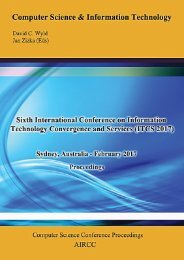CoSIT 2017
Fourth International Conference on Computer Science and Information Technology ( CoSIT 2017 ), Geneva, Switzerland - March 2017
Fourth International Conference on Computer Science and Information Technology ( CoSIT 2017 ), Geneva, Switzerland - March 2017
Create successful ePaper yourself
Turn your PDF publications into a flip-book with our unique Google optimized e-Paper software.
36 Computer Science & Information Technology (CS & IT)<br />
Table 1 – Wavelet coefficients for (a) Original tag detection – when the antenna is loaded with tag only (b)<br />
Hand on top of tag – when the hand is placed at 5cm distance above the tag (c) Copper plate on top of tag -<br />
when a copper plate of dimensions 10× 10× 0.2mm is placed at 5cm distance above the tag (d) Tag moved<br />
to the corner of antenna - when the tag is placed in the corner of the antenna<br />
Resonance<br />
Freq.<br />
(GHz)<br />
Original tag<br />
detection<br />
(Coefficient value)<br />
Hand on top<br />
of tag<br />
Copper plate on<br />
top of tag<br />
Tag moved to<br />
corner of<br />
antenna<br />
4.15 10.14 14.53 10.15 14.53<br />
4.70 10.25 17.35 10.25 17.35<br />
5.37 10.32 12.88 10.32 12.88<br />
6.10 10.29 13.26 10.29 13.26<br />
6.95 10.27 16.72 10.27 16.72<br />
The frequency domain reader developed in MMARS lab uses the same patch antenna design for<br />
detection and is working in the frequency range of 4 – 7.5GHz. Therefore future direction of this<br />
research will be the implementation of the novel detection algorithm in firmware.<br />
5. CONCLUSIONS<br />
According to these results, it can be seen that a hand or conductive material (Cu) placed in the<br />
close vicinity of the tag (less than 10cm) will have an effect on the magnitude of the tag<br />
measurement. Still applying the novel detection algorithm the tag can be identified even if the<br />
conductive material is placed covering the tag. Also, when the tag is moved around the surface<br />
area covered by the antenna, the tag can be detected using this detection algorithm. Since the<br />
experiment was conducted by placing the clutter only on one side of the tag, more experiments<br />
should be performed by varying the position, size, material, etc. to conclude the probability of<br />
error due to the different material surrounding the tag.<br />
An advantage of this detection algorithm is that it could detect up to a minimum of 1dB<br />
magnitude variation with added noise. The adaptability of the wavelet is another advantage of this<br />
algorithm as it can be applied for any type of tag in time domain or frequency domain and could<br />
cover the required frequency range. Also the detected bit resolution is high, which leaves room<br />
for the applications with higher number of bits in future.<br />
When compared with other algorithms this has the most adaptability to any kind of chipless RFID<br />
system. Comparing the number of bits of a tag, the presented algorithm can be applied for higher<br />
number of bits whereas algorithms developed by Kalansuriya[3], Rezaiesarlak [6] and<br />
Divarathna[7] are implemented for low number of bits due to their mathematical complexity. As<br />
the width of the wavelet used in the detection is only 10MHz, with a guard band of another<br />
10MHz a 20bit tag can be easily detected in the given frequency range of 4-8GHz.





